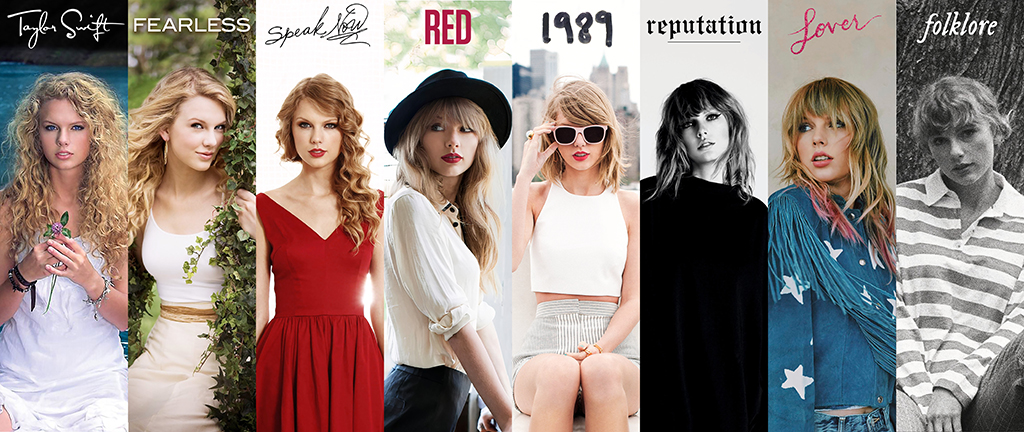Music Blog: Taylor Swift Shifts Genres, Again (Part 1)


To take a broader lens, the impressive thing about Swift is that she’s continued to adapt as she sees fit, rather than jumping on short term success. This is evident in her shift from country to pop and now to indie-folk, none of which were really based on a drive for more commercial success, as she’s experienced such success from her debut as a teen country idol. Swift is a true musician who craves expertise and improvement, and that sort of passion is attractive no matter what form it takes.
For her first seven studio albums, Swift’s style was primarily autobiographical in a general way, chronicling her many youthful mishaps with love, her dreams, her failures and successes. Many of her songs played out like personal letters, not at all unlike one might find in an average young woman’s diary (albeit far more lyrically adept). This isn’t uncommon among songwriters, and Swift gained millions of fans over the years who adored her frank storytelling and musicality. However, over the course of the past year, Swift has sampled a different approach. She released the first of her two sister albums, folklore, in July of 2020, and the subsequent evermore in December of 2020. Both of these indie-folk albums she has described as folktales of her own making, centering on themes across humanity expressed in the form of fiction mixed with selectively chosen personal experience. In folklore, Swift drew inspiration not only from her own life, but from a full cast of characters, including Rebekah Harkness, the previous owner of Swift’s current Rhode Island mansion, and a trio of fictional teens Swift created for a corresponding trio of songs fans have since dubbed “the teenage love triangle.”
Aside from obviously referencing subjects other than Swift herself, however, the folklore tracks feature heavily poetic and visual language, a noticeable contrast from her signature style. This isn’t to say Swift has not always been a proficient songwriter — she has historically dramatized her writing so it reads more like a novel than a generic pop song. However, folklore revels in elegiac and illustrative ambiguity, most significantly, I think, in songs like “invisible string” and “hoax.” In the former, Swift sings:
Cold was the steel of my axe to grind
For the boys who broke my heart
Now I send their babies presents
Gold was the color of the leaves
When I showed you around Centennial Park
Hell was the journey but it brought me heaven
This is quite the difference from the 2012 album Red where Swift sings “Begin Again,” a song with similar tempo and subject. In the second verse of Begin Again, as opposed to the aforementioned second verse of “invisible string,” Swift sings:
Took a deep breath in the mirror
He didn’t like it when I wore high heels, but I do
Turn the lock and put my headphones on
He always said he didn’t get this song but I do, I do
It’s clear that in “Begin Again,” Swift speaks to a nearly universal experience in which the broken-hearted heal with the encountering of a new love. In “invisible string,” although the message speaks more of already fully healed hearts, Swift offers listeners an intimate look into her reflective side, as well as creates a semi-fantastical world of poetic interpretation and soft spoken detail, leaving it to her audience to find aspects of her life and her writing to relate to rather than primarily catering to them. The same is true in “hoax,” where Swift sings, “Stood on the cliffside / Screaming, “Give me a reason” / Your faithless love’s the only hoax / I believe in.” The chorus whisks listeners away to a misty grey cliffside to envision a mourning Swift weeping over the edge, almost like the opening scene to a movie.
It’s attractive to see someone like Swift, who built her empire on being America’s sweetheart and representative of lovesick young people everywhere, give us a glimpse into what seems to be an unfiltered stream of her inner musings, not commercialized, made-for-radio pop/pop-country (although, let’s be honest, there’s not any one of us here who can’t get down to “22”). It’s also refreshing to watch Swift branch out into a more creative medium where she’s able to spin stories rather than simply recount them.
Although the songs on folklore will likely never make it onto my “tearfully scream out the car window” playlist, listening to them transport me into an imaginative headspace like no other album I’ve heard. I’ve always been a big fan of fairy tales, and here, Swift has compiled her own book of folklore to be enjoyed through the ages.
Next Post: Taylor Swift Shifts Genres, Again – Part 2
Other Music posts by Johanna Seng:
Making the Perfect Playlist
Dissecting Lo-Fi Hip-Hop
Mele Kalikimaka
A Private Rebellion
